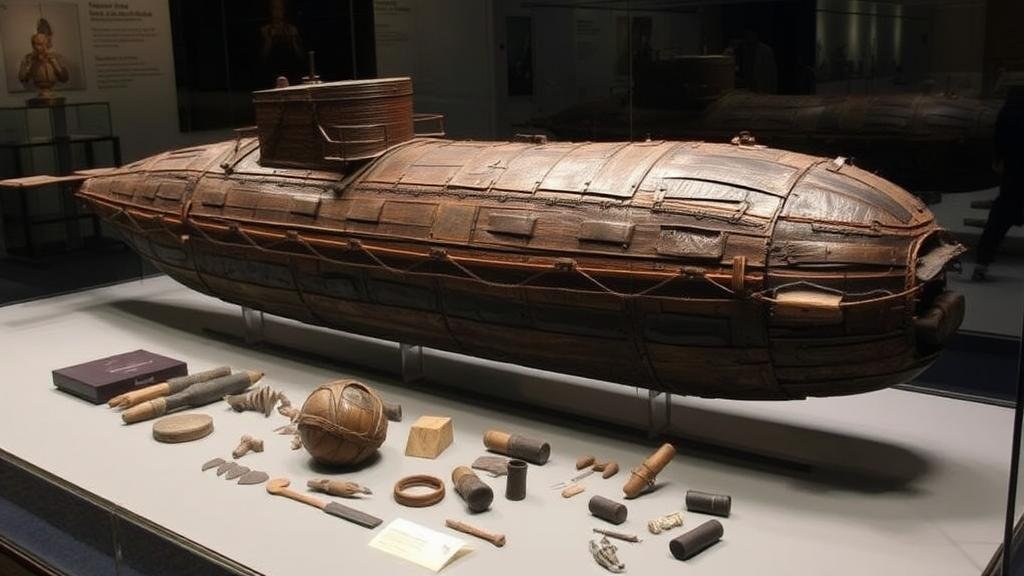The Lost Confederate Submarine Hunley: Its Artifacts Provide a Glimpse Into a Historic Civil War Vessel
The Lost Confederate Submarine Hunley: Its Artifacts Provide a Glimpse Into a Historic Civil War Vessel
The Confederate submarine Hunley, launched in 1863, marks a significant chapter in naval history, symbolizing innovation during a tumultuous time. As the first combat submarine to sink an enemy warship, its story goes beyond its military significance; it encapsulates the technological aspirations and the grim realities of warfare during the American Civil War. The recovery of the Hunley and its artifacts has provided historians and archaeologists a unique window into this pioneering vessels operational and cultural context.
The Historical Context of the Hunley
Constructed in Mobile, Alabama, the Hunley was built as a response to the Union blockade that was crippling Southern supply lines. Designed by Horace Lawson Hunley and his partners, the submarine was crafted from iron and was powered by a hand-cranked propulsion system, enabling it to navigate underwater.
The vessels first significant mission occurred on February 17, 1864, when it successfully attacked the USS Housatonic, a Union ship, sinking it in Charleston Harbor. Unfortunately, the Hunley itself mysteriously sank shortly after this engagement, resulting in the loss of all eight crew members. The fate of the Hunley remained a mystery for more than a century, and its recovery in 1995 marked a turning point in our understanding of Civil War naval tactics.
Artifacts and Their Significance
The excavation and preservation of the Hunley yielded a wealth of artifacts that offer invaluable insights into life aboard this early submarine and the ethos of its crew. Key artifacts include:
- Brass signaling lanterns that suggest attempts to communicate covertly.
- Personal belongings, including buttons and pipes, that resonate with the humanity of the crew members.
- Tools and equipment used to operate and navigate the vessel.
These artifacts collectively narrate the practical challenges navigated by the crew–limited oxygen, extreme pressure, and the absence of reliable lighting. Also, the artifacts allow historians to explore the submarines operational procedures, including the methods of propulsion and navigation utilized by the crew.
Technological Innovations and Adaptations
The Hunley represents a fusion of innovative engineering and desperate military needs. Its design anticipated features seen in modern submarines, such as stealth and concealment strategies. Some technological aspects include:
- Iron construction that provided better resilience against enemy fire.
- A unique propulsion system that allowed for maneuverability.
- An early form of a torpedo, which was used to deliver explosive payloads against enemy vessels.
Failure to survive operational challenges emphasizes the risks taken by the crew. The strategic use of innovative weaponry was a double-edged sword, weighing on the decision-making processes within naval warfare at the time.
Cultural Impact and Legacy
The cultural legacy of the Hunley extends beyond its use in warfare. It symbolizes the ingenuity and endurance of the Southern war effort, reflecting the desperation and resolve of a defeated nation. Public fascination with the Hunley has arisen since its rediscovery, evidenced by numerous documentaries, books, and exhibits–such as the one hosted at the Charleston Museum.
The continuing study of the Hunley not only sheds light on 19th-century military technology but also allows for discussions surrounding broader themes, including human sacrifice and the moral complexities of warfare. For example, the loss of life aboard the submarine raises ethical questions regarding the value of human life versus military objectives during wartime.
Conservation and Education
Efforts to conserve the Hunley and its artifacts have been extensive, involving advanced techniques in archaeology and preservation. The state-of-the-art conservation practices used in the recovery and restoration of the Hunley set a precedent for similar historical endeavors worldwide.
Also, educational initiatives surrounding the Hunley allow for greater public engagement with Civil War history. e initiatives often encourage discussions about the evolution of naval warfare and technology. Also, the artifacts serve as tangible links to the past, making history accessible and relatable to diverse audiences.
Conclusion
The story of the Hunley offers profound insights into innovation, sacrifice, and the complexities of human endeavor during wartime. The artifacts recovered not only tell the tale of an experimental military vessel but also provide a lens through which we can examine the broader implications of technological advancement and cultural heritage. In a world where new technologies continuously reshape warfare, the legacy of the Hunley serves as a reminder of the past sacrifices made in the relentless quest for progress.
As we continue to study and preserve such historical artifacts, we must also embrace the educational opportunities they present–illuminating both our progress and the costs associated with it.



